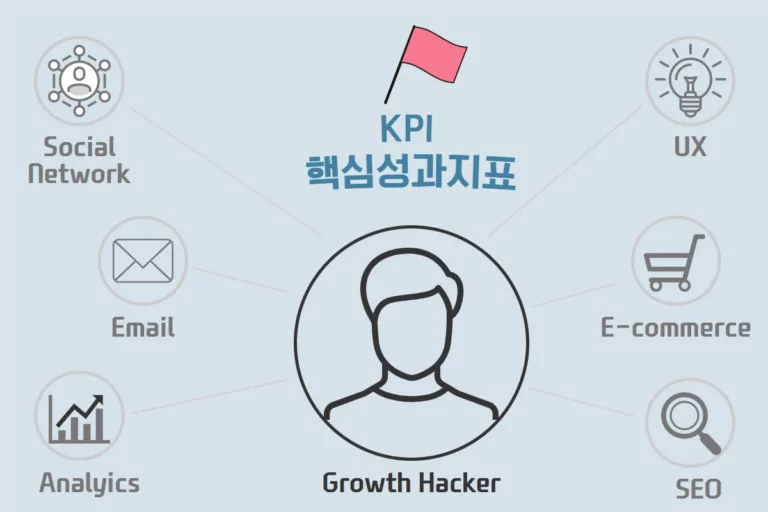Before we dive into Growth Hacking, let’s define marketing. The term “marketing” combines “market” and “-ing,” encompassing all activities that make a market function. It’s not just about advertising and promotions for product sales.
Most business activities fall under the marketing umbrella. This includes everything from conceptualizing the product, producing prototypes, mass production, distribution, sales, promotions, to customer service (CS).
In a broad sense, marketing isn’t much different from overall business activities.
Growth Hacking: A Marketing Methodology for Finding Minor Gaps
What is Growth Hacking?
Growth Hacking means using all possible means (Hacking) to achieve growth.
Like finding minor vulnerabilities in a target to hack, it is a marketing methodology that identifies and aggressively targets customers and distribution points for growth.
Initially, it involves hypothesizing strategies to increase brand, company, or product sales and quickly launching a Minimum Viable Product (MVP) model to get market feedback.
Based on the reactions from consumers and the market, the product or service is continuously improved until it becomes the perfect product desired by the market (customers).

The term ‘Growth Hacking’ was first used by Sean Ellis, author of “Hacking Growth: How Today’s Fastest-Growing Companies Drive Breakout Success,” who was the first marketing manager at Dropbox.
During Dropbox’s early stages, he spread the demo version on social media to gather initial users. Through data analysis, he found that most new users were referred by friends, leading to the ‘Friend Referral’ campaign.
This provided both the referrer and the new user with an additional 500MB of free storage, creating a viral effect among users and achieving significant marketing success.
As the term suggests, Growth Hacking maximizes efficiency and rapidly grows products and services through all means necessary for growth.
These means include data-driven analysis and market feedback to improve and expand products and services. This approach is particularly effective for startup companies with limited capital and resources.
Goals of Growth Hacking
Maximizing Low-Cost, High-Efficiency Viral Marketing
Traditional marketing strategies focus on promotional activities to make an already complete product known to more consumers.
In contrast, Growth Hacking incorporates marketing elements throughout the entire process of producing products and services.
The first version of the product is released to the market to gather consumer feedback, which is then used to improve the product. This improved product is released again, and consumer behavior patterns are analyzed.
Repeating this process allows consumers to have increasingly satisfying purchasing experiences, which naturally leads to word-of-mouth advertising.

In other words, it analyzes buyer behavior patterns and optimizes user experience based on that analysis.
Growth Hacking involves creating products that satisfy consumer wants from production to management.
During the process of evolving into a product that perfectly matches consumer tastes, advertising effects naturally occur.
This is especially true for service improvements, which accumulate positive brand experiences, leading to high viral effects.
Hence, ‘low-cost, high-efficiency growth’ is the essence of Growth Hacking. Additionally, the continuous improvement of products and services leads to the overall growth of the company.
Growth Hacking and Growth Marketing: Methods for Securing Potential Customers
Growth Marketing
Industry professionals often use ‘Growth Marketing’ and ‘Growth Hacking’ interchangeably. Growth Marketing derives from the concept of Growth Hacking, applying it to actual marketing.
From the product conceptualization stage, it actively utilizes big data analysis to create products. Then, users are attracted through various platforms such as email, blogs, and social media, using metrics like:
- CPM (Cost Per Mile: cost per thousand impressions)
- CPC (Cost Per Click: cost per click)
- CPL (Cost Per Lead: cost per lead, e.g., sign-ups, event participation, survey responses, comments)
- CPA (Cost Per Action: cost per action, e.g., purchases, adding to cart)
- Visitor numbers
These objective metrics help to continually research the company’s products and understand the target audience’s wants.
Insights allow to formulate new marketing strategies and continually improve the product until it meets consumer expectations, similar to Growth Hacking. Growth Marketing is a technique for securing potential customers through three stages: tracking, verification, and expansion.
Growth Hacking: Growth of Key Performance Indicators
Growth Hacker

There are professionals who specialize in analyzing these objective metrics and devising strategies to secure potential customers.
If Growth Hacking grows products and services, ‘Growth Hackers’ grow the metrics.
They meticulously investigate the market’s potential elements based on KPIs (Key Performance Indicators) and remove the boundaries between service and marketing.
They work to ensure that consumers build brand experiences within the ‘service itself’ and naturally become ‘communication (marketing)’ agents to other customers.

Growth Hackers aim to create automated marketing structures within this marketing framework, where consumers themselves propagate to millions of people and sustain this propagation.
They design the foundation for continuous company and product appeal by letting consumers build and transform the ambiguous value of ‘branding.’
Applying Growth Hacking to Your Business
As discussed, Growth Hacking is a marketing methodology that identifies customer problems based on data, tests hypotheses to achieve goals, and continuously improves the product.
It doesn’t necessarily require hiring a Growth Hacker or checking specific metrics. All decisions for continuous and steady growth start with data-based hypothesis formulation.
These hypotheses are verified through small experiments, leading to product improvements and sustained growth. This is the essence of Growth Hacking.
We believe that explosive growth along the so-called J-curve can be detrimental in the long run. A restaurant bustling with customers from day one may reveal issues such as food quality, service speed, and cleanliness. These problems can drive customers away once the initial excitement fades.
Therefore, we believe that planned and prepared growth to enhance customer satisfaction is more important. Growth Marketing Agency takes a marketing approach that makes time our ally.



